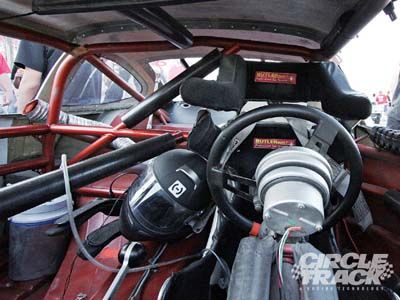
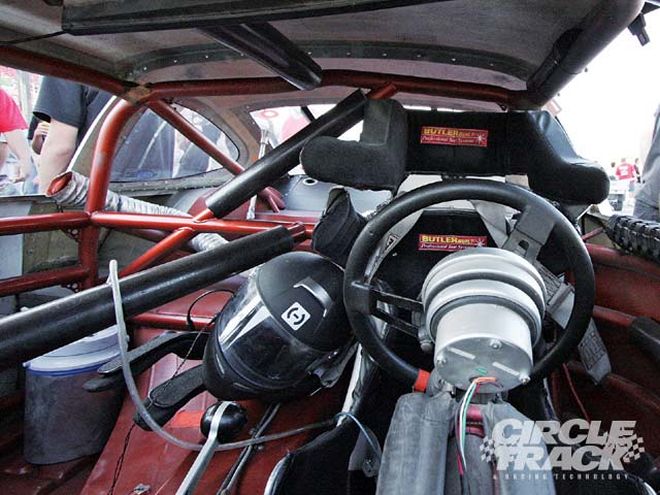 Things can get a little cramped inside the cockpit of a race car these days, and with so many things vying for your attention it's easy to find yourself distracted during the middle of a race.
Things can get a little cramped inside the cockpit of a race car these days, and with so many things vying for your attention it's easy to find yourself distracted during the middle of a race.
Before drivers can consider racing their car or even their competitors, they have to do battle with different elements inside the cockpit. Whether it's Street Stocks on a Friday night or Sprint Cup on Sunday afternoon, race car drivers all have to deal with the same issues: temperatures way above 100 degrees inside the cars, fatigue, and dehydration.
A driver's greatest enemy is heat. With all the safety equipment that is being worn now-the driver's suit, gloves, head-and-neck restraint systems, and racing shoes-drivers are being exposed to extreme ranges of high temperatures. Even go-karters and Legend drivers are subject to these extremes when their heat races or qualifying attempts are run on a July or August afternoon in the hottest and the most humid part of the day.
A full-body Late Model or Street Stock driver has similar issues, because in these cars, the exhaust systems are usually run underneath the driver's feet and the heat from the engine and transmission is intense.
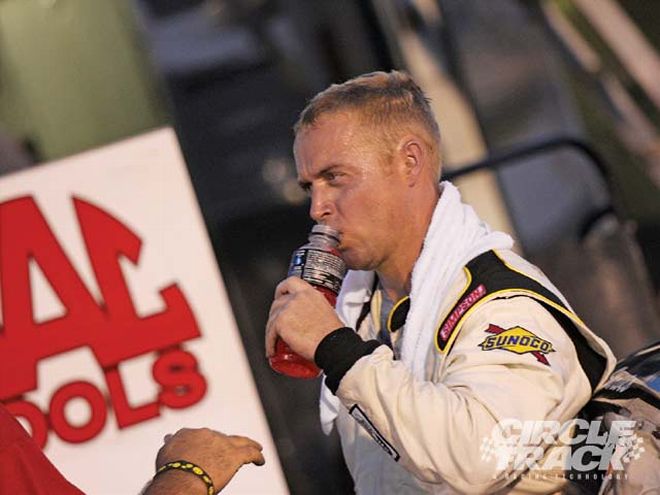 Avoiding the sodas and replacing them with water and sports drinks can go a long way to ensure that you stay focused inside the race car.
Avoiding the sodas and replacing them with water and sports drinks can go a long way to ensure that you stay focused inside the race car.
We've all heard stories of race car drivers who have lost significant weight from sweating during a race. I recently competed at Radford, Virginia's Motor Mile Speedway on an extremely warm Saturday. The following Monday, two days after the race, I happened to jump on the scales and found that I was still about 3 pounds off my normal weight
So, what's the big deal about losing a little weight? Most of us could stand to lose a few pounds here and there anyway, right? This type of weight loss is fluid loss from dehydration and it can have significant negative physical effects on the body. Fluid loss can lead to a decrease in the amount of blood flowing throughout the body. This means we have less oxygen reaching our vital organs, and we're much more likely to suffer from impaired concentration, decreased energy, and fatigue-not something we want while in the cockpit of a race car.
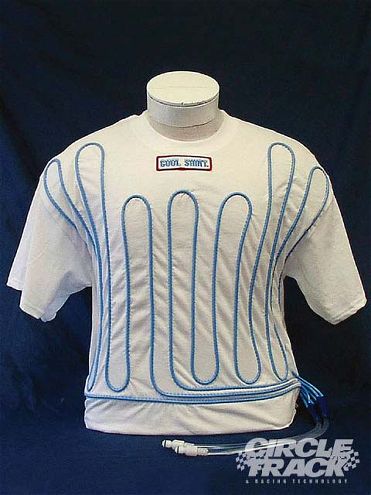 A Cool Shirt like the one shown here will run 45-60 degree water temperatures throughout your shirt to help cool your body temperature and help provide better concentration and focus.
A Cool Shirt like the one shown here will run 45-60 degree water temperatures throughout your shirt to help cool your body temperature and help provide better concentration and focus.
There are a few ways that a driver can combat the effects of heat, become more comfortable, and hence more effective inside of his or her race car. We've all heard it before, but exercising regularly and eating right will do wonders for you. It could be as simple as just running 15 minutes a day and replacing the soda that you normally drink at lunch or dinner with water. The American College of Sports Medicine recommends that regardless of the sport, athletes should be well hydrated before competition, drinking at least 16 ounces of fluid (water, juice, sports drinks) a couple of hours before exercise, and another 8 ounces 30 minutes before exercise. This will help prevent dehydration and help sharpen your focus while you're inside the car.
"Cool" Shirt Now once you're strapped into your seat, there are a few products that you can use inside your race car that will help you combat the heat. One of those products is a Cool Shirt. A Cool Shirt is a garment designed with 50 feet of tubing incorporated into it that covers 30-40 percent of your skin's surface with temperature-controlled cool water. The idea is to maintain a safe body temperature. The shirt comes with a quick disconnect so that when you're getting out of the car, you can disconnect the hoses without fear of spilling a lot of water. It also comes with a temperature controller so you can adjust it if you feel yourself getting too cold. Remember, if your body gets too cold, you will start to shiver and the purpose of shivering is to heat the body-not a good combination in more than 100 degree temperatures, and not something you want to have to deal with when you're concentrating on driving.
The Cool Shirt uses a personal cooler inside your car filled with ice and water. Once you've plugged into the quick disconnect, all you have to do is turn on the pump and it will start pushing the cool water through your shirt, reducing sweating and the effects of dehydration for 3 to 6 hours depending on the system.
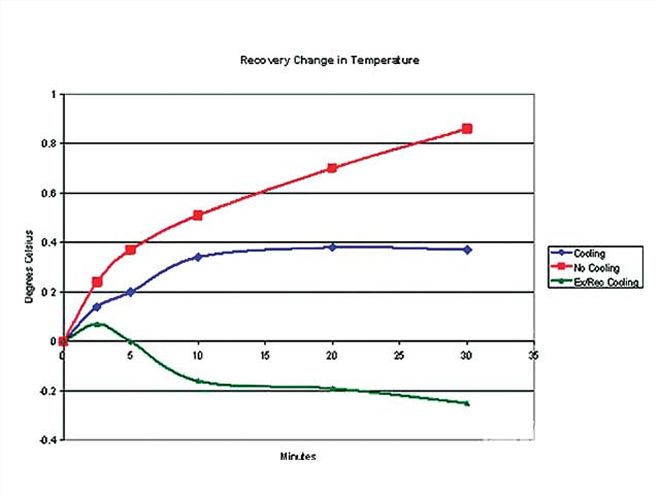 This is a graph of the effects when using the Cool Shirt. The subject here was on a treadmill and was running in 95 degree weather. As you can see, when he wore the Cool Shirt during the exercise and after when he was resting, his body temperature actually was cooler than when he started.
This is a graph of the effects when using the Cool Shirt. The subject here was on a treadmill and was running in 95 degree weather. As you can see, when he wore the Cool Shirt during the exercise and after when he was resting, his body temperature actually was cooler than when he started.
A respected university tested the system with a 20-year-old, healthy marathon runner in 95 degree weather. It had him run 15 minutes and then rest for 30 minutes while still in the 95 degree weather. Without a Cool Shirt he ended up loosing 5 pounds. Once he put on the Cool Shirt and did the exact same routine, he only lost 1.4 pounds. Imagine what this could do for you in your race car, especially if you race in long events.
Drink Lots One of the easiest ways to cool the driver is to simply make sure you have access to plenty of fluids during the race. A lot of drivers will simply put a small cooler with ice water inside their car. Personally, I use a drink bottle holder that attaches right to the chassis inside of the cockpit. It comes with 3 feet of hose with a bite valve on one end, so that when you are finished drinking, you can set down the hose and not have to worry about the water siphoning itself all over the floorpan of your car. I've been involved in my fair share of racing accidents and have yet to have any water spill in my car. Remember too, as you sweat, you lose valuable electrolytes, and you need something in your water bottle to replace them. There are many sports drinks on the market and a lot of drivers will use a drink like Pedialyte. Whether it's one of these, or just plain water, the key is to consume lots of fluids prior to and during the race.
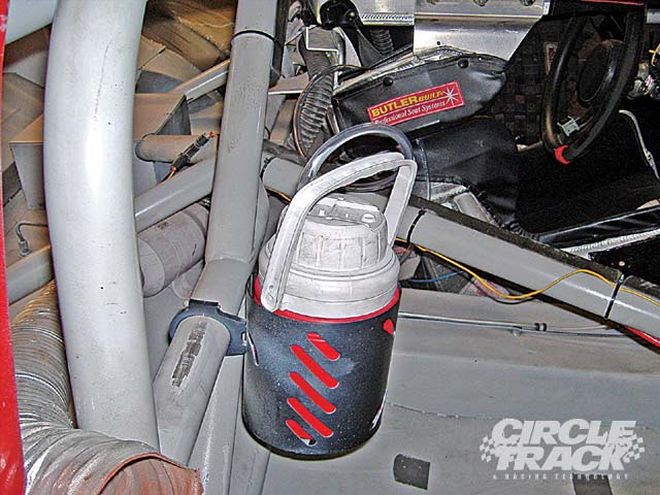 An ice-cold drink can help a driver immensely during a race. The drink here is mounted straight to the chassis and the hose is run right into the driver's seat so he can reach it easily.
An ice-cold drink can help a driver immensely during a race. The drink here is mounted straight to the chassis and the hose is run right into the driver's seat so he can reach it easily.
One thing I've seen done should be avoided. Drivers will get so hot during cautions or red flag conditions, that they take their water bottle and open it up and pour it on themselves. This is something you do not ever want to do, because as soon as the race starts back up and the temperature in the car starts to rise, so will the temperature of the water that you poured all over your suit. Pretty soon, you'll feel as if you are boiling in your suit. It's better to continue to just drink your water in the car.
Breathe Clean Many drivers run some type of cool-air box inside their race car, which is a great way to keep the driver cool. But if you run one of these, you need to check your cool-air box to see if it filters out carbon monoxide. Street Stock and Late Model drivers, this is especially important for you. After a few crashes or a few times of bottoming out the car, you may wear a hole into your headers or exhaust. Depending on where the exhaust leak is, it could leak carbon monoxide right into the cockpit of your car.
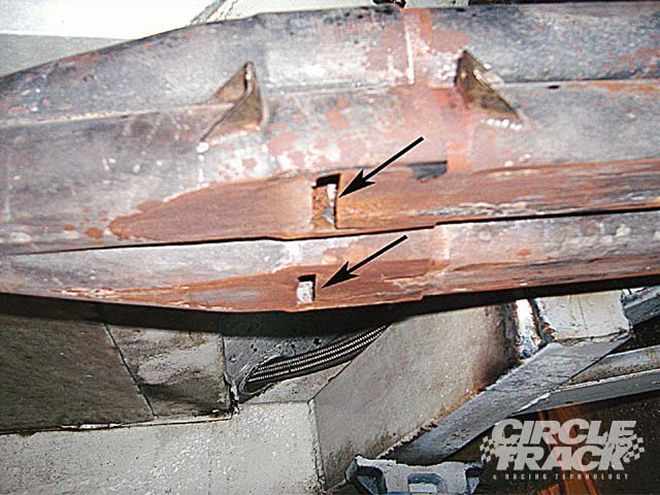 This hole is right where the headers and the collector meet which is directly below the driver's compartment. This particular collector has been run so much that it has been ground down to next to nothing. A hole this large will dump lethal amounts of carbon monoxide into the driver's compartment.
This hole is right where the headers and the collector meet which is directly below the driver's compartment. This particular collector has been run so much that it has been ground down to next to nothing. A hole this large will dump lethal amounts of carbon monoxide into the driver's compartment.
Brad Smith of RH2 Radios experienced this while driving a Modified in a 150-lap race a few years ago and during the race felt himself sinking in the seat and felt like he couldn't pull himself back up. He passed out toward the end of the race and woke up to one of his crewmembers talking to him on pit lane after the race. He had finished in the top five, but he had no memory of how he finished. The next day after a visit with the doctor, he found out that he suffered from carbon monoxide poisoning.
Here's the bad news: Carbon monoxide is odorless, colorless, and tasteless. Many times the symptoms get mistaken for overheating or the flu because they are so similar-headache, nausea, fatigue, shortness of breath, and fainting. One of the tell-tale signs that you might be suffering from the beginning stages of carbon monoxide poisoning is a headache. If you consistently have a headache after a race then you need to start looking at your exhaust system to see if you can find any leaks. The good news, however, is that there are a few products available to filter out carbon monoxide.
For the longest time, cost was a problem since most CO filters were expensive and out of the short track racer's price range. Some CO filters run into the thousands of dollars. Sure, NASCAR Sprint Cup guys can afford them but two grand to a short track racer is 10 tires, or in some classes the entire car! But there's an option, a very good option.
The NoMo Co retails for $189 and comes with one particulate filter and two CO filters. Designed and manufactured by Cat-5 Racing Technologies, the NoMo Co removes 97-98 percent of carbon monoxide from your helmet ventilation system. It features a particulate filter at the beginning of the air inlet hose which prevents any pieces of rubber or dirt from entering your helmet through the air system. From there, the air travels through the hose to the CO filter where the carbon monoxide is removed. Finally, the clean air makes its way into your helmet. While you can use different blowers, the system works best with a brake blower-type helmet blower.
The CO filters will last approximately 6 hours and cost $35 to replace. The filters need to stay moist to be able to catch the carbon monoxide. Once they dry out, they're no longer able to provide clean air to the helmet. Mark Orlando, owner of Cat 5 Racing Technologies, suggests removing the CO filter when not in use, such as after practice and before the feature, and placing it in a Ziploc bag. This will help keep the filter moist and in top working order.
With everything we have to deal with getting the race car ready and to the track, sometimes things like comfort and staying well hydrated take a back seat. However, by keeping the driver more comfortable inside the race car, he or she is better equipped to focus on the task at hand-racing.